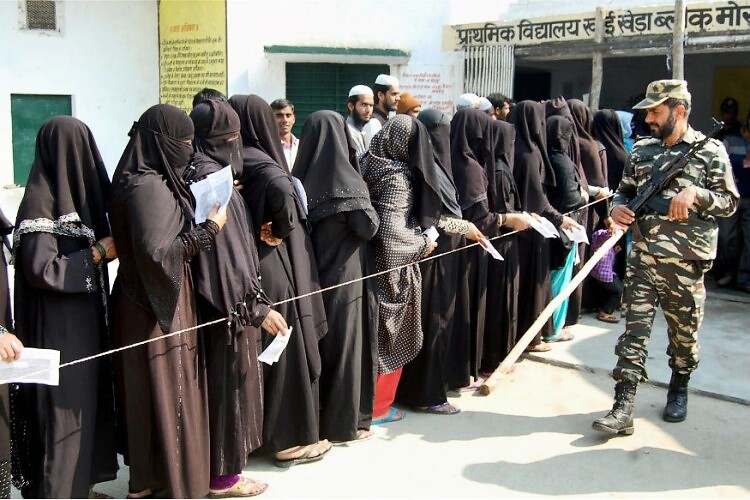
views
Meerut: The first phase of the 2017 UP assembly elections were concluded at 5pm on Saturday with 64.22% of the electorate in western UP coming out to vote.
The first phase of the elections saw polling in 15 districts, 73 Assembly constituencies and 839 candidates in the fray. Over 26,000 polling booths had been set up across the 15 districts for over 2.60 crore people who came out to vote on Saturday.
The turnout in the first phase was more than that in 2012, when 61.5% turnout was recorded. The highest turnout was recorded in Shamli district at 67.12% and the lowest was in Ghaziabad at 58.1%. The constituency with the highest turnout, however, was Fatehabad in Agra district.
Several heavyweights, including former UP BJP chief Laxmikant Bajpai, riot-accused BJP MLA Sangeet Som, riot-accused UP BJP vice president Suresh Rana, state cabinet minister Shahid Manzoor, senior BSP leader Yaqub Qureshi, Home Minister Rajnath Singh’s son Pankaj Singh and Congress Legislative Party leader Pradeep Mathur, were in the fray in the first phase of polling.
As the most communally sensitive belt of Uttar Pradesh, the first phase was believed to be BJP’s game to lose. In the 2014 Lok Sabha polls, the influential Jat community in western UP came out to support the BJP in droves.
This time, however, the dynamic seems to be shifting as since the last year, several Jat outfits have protested against the BJP claiming that the party had “betrayed” the Jat community.
Polling, which was slow in the morning, picked up around noon. The first phase was also not devoid of problems.
In the early hours, there were reports of an EVM malfunction in Bulandshahr district, which led to a slight delay in voting.
Gagan Som, the brother of riot-accused Sardhana MLA Sangeet Som, was detained by the police after he was caught carrying a gun inside a polling booth. The firebrand BJP lawmaker got into an altercation himself when later in the day, some voters, reportedly supporters of BSP and SP, tried to stop Som from entering a polling booth in Sardhana.
Samajwadi Party veteran and State Cabinet Minister Shahid Manzoor also got into an argument with a group of voters who were reportedly BSP supporters. This reportedly led to minor clashes between BSP and SP workers in a village in Khithore, which is Manzoor’s Assembly constituency.
Among the 15 districts that went to polls on Saturday, western UP’s ‘Jat belt’ reported higher turnout than the region-wide average. The Jat-dominated district of Shamli, which also houses the hot seat of Kairana, polled 67.12% of the vote.
Mathura, the district with the highest concentration of Jats in western UP, polled 65.39% of the votes. Baghpat, which is the home-district of Rashtriya Lok Dal (RLD) chief Ajit Singh, recorded a turnout of 64.99%.
Muzaffarnagar district, which was the flashpoint of the 2013 Jat-Muslim riots, recorded a turnout of 66.50%.

An incident that threatened to polarise western UP further was the murder in Bijnor the night before polls. While Bijnor doesn’t go to polls till February 15, the second phase of the elections, its proximity to districts such as Meerut and Muzaffarnagar is likely to influence voters.
On late Friday evening, a farmer and his son had gone to water the fields when a dozen men, allegedly belonging to another community, attacked them with knives and guns. The son, 17-year-old Vishal Kumar, was killed in the attack.
Communal tensions in Bijnor were high as BJP workers on Saturday blocked traffic on one of Bijnor’s main crossings for around five hours. Traders also downed shutters in protest of the murder.
Police have been deployed all across Bijnor to prevent the situation from worsening any further.
According to political analysts, while it is hard to tell who has the edge based on turnout alone, the first phase is crucial for all parties in determining who will end up maintaining the momentum in later phases.
“The first few phases, especially phase 1, are crucial if a party wants to maintain momentum going further into the elections. By around phase 3, word will start travelling to the eastern corners of the state about who is doing well in the elections.
The BJP swept UP in 2014 on the back of its performance in western UP and since the phases moved from west to east, they ended up doing well in the other areas as well.”




















Comments
0 comment